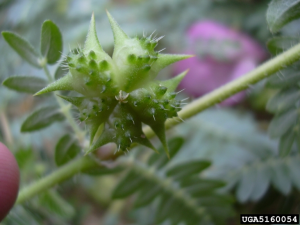Puncturevine (Tribulus terrestris) is aptly named! This invasive weed has spiny seed heads on it that can easily puncture a bike tire, inflatable raft, animal paw, or footwear. Be on the lookout because it is beginning to make its way into Clackamas County from eastern and southern Oregon. By chance, District staff came upon (and destroyed) a small patch in the parking lot of the 2016 Clackamas County Fair! We returned to the site just a few weeks ago and discovered another patch — a great reminder to have a maintenance plan in place!
Also known as “goathead”, puncturevine is native to southern Europe. This Oregon Class B noxious weed thrives in hot, dry, rocky conditions where other plants cannot. Look for it along roadsides and in gravel parking lots, but note that this opportunistic weed can also show up in orchards, pastures, and ditches.
How Can I Identify Puncturevine?
Puncturevine is a summer annual broadleaf weed that generally grows low to the ground, forming dense mats two to five feet in diameter. Stems from the plant radiate out from the center and can spread up to six feet. Flowers are small, yellow, and have five petals. The leaves are hairy, one to three inches long, and divided into leaflets, each about 1/4 of an inch long.
The most notable aspect of puncturevine is its dangerous and numerous seed heads! These seeds use their long spikes to attach themselves to passing animals, tires, or people. Once they germinate in the spring, they speedily produce a deep taproot and can begin flowering within three weeks of germination. Puncturevine seeds can remain viable in the soil for up to five years and a typical plant will produce 200 to 5,000 seeds during one growing season.
Why Should I Care About Puncturevine?
Puncturevine poses a serious problem for agriculture and recreation here in Clackamas County. The plant quickly develops a deep taproot, allowing it to aggressively compete for water and nutrients needed by trees, field crops, or native plants. If it makes its way into a hay crop, the hay may become unsalable, as the sharp spines of the seed can injure the mouth and digestive tract of animals. Additionally, puncturevine can be toxic to sheep and cattle, causing nitrate poisoning, blindness, and death in young animals.
Are you, your friends, or family outdoor recreationists? Puncturevine can turn a lovely day into a disaster by puncturing equipment, a pet, or a person. The spiny thorns of the pucturevine seeds are notorious for flattening bike tires, leaving recreationists stranded. The tender paws of pets are extremely susceptible to the thorny seeds.
How Can I Control Puncturevine?
While puncturevine is certainly a painful pest invader, there is good news. Puncturevine is easily removed by hand once detected. Just be sure to pull the entire taproot and then bag all parts of the plant and place in the garbage for landfill disposal. Be sure to gather up any seeds that may have dropped to the ground during removal. Do not dump pulled weeds or the infestation will just begin anew in another area.
Once seed is established, monitor and remove plants as they emerge and continue to do so for several years. Shallow tilling of seedlings or small plants can be effective in larger areas. Two weevils have been used successfully as a biological control, but are not sufficient by themselves to manage puncturevine.
Keep puncturevine from spreading by thoroughly checking and cleaning clothes, pets, equipment, and vehicles. For more information on chemical control of this invasive plant, please contact our WeedWise team at 503-210-6000.
Report Puncturevine!
Have you noticed invasive puncturevine in your area? If so, please report your sightings to the District’s WeedWise program by giving them at call at 503-210-6000, or submit your information online to the Oregon Invasive Species hotline. Your help in identifying and reporting locations of puncturevine in our community will help to stop the next invasion before it starts!

Our mission: We help people conserve and use natural resources sustainably today and for future generations.



